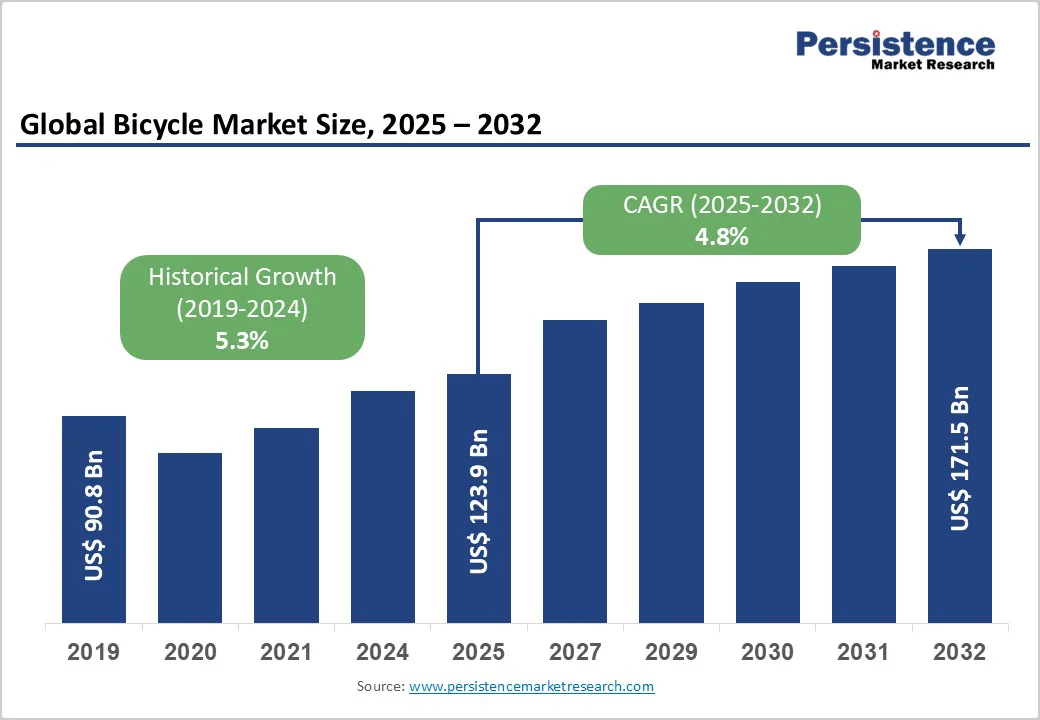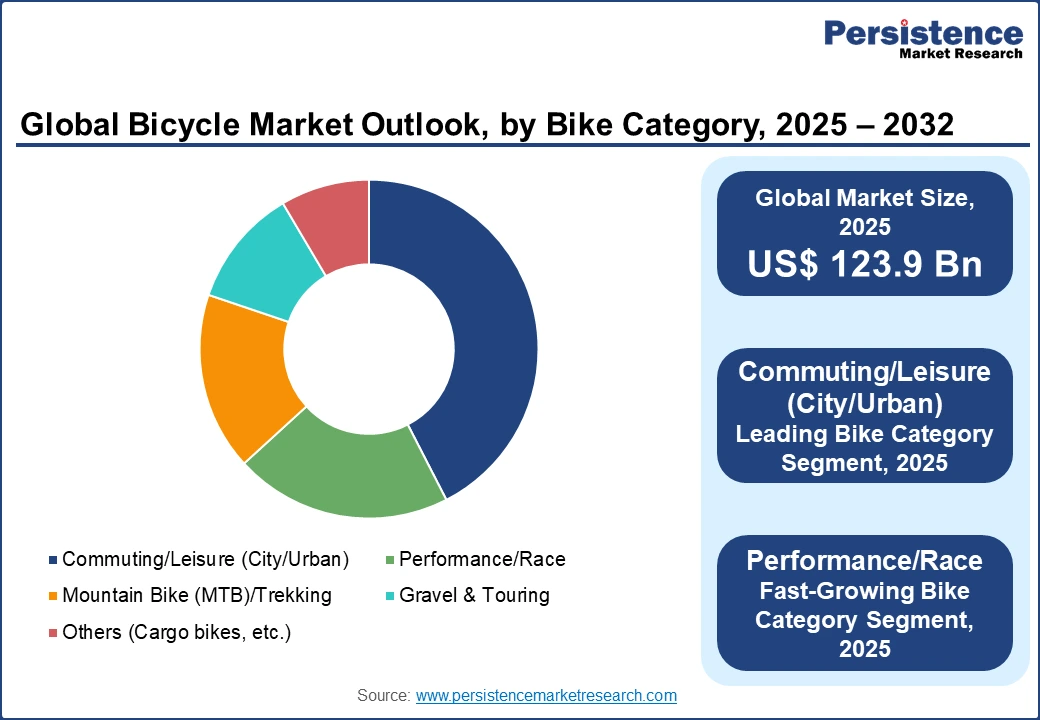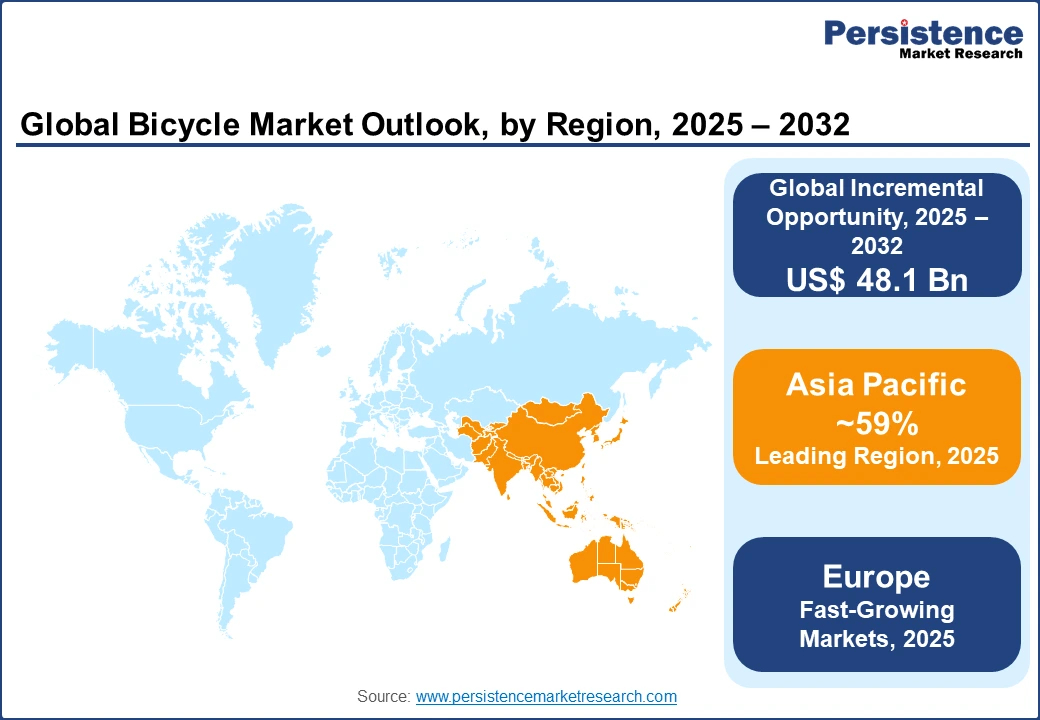ID: PMRREP3326| 177 Pages | 3 Nov 2025 | Format: PDF, Excel, PPT* | Automotive & Transportation

The global bicycle market is expected to reach US$123.9 Bn by 2025. It is anticipated to experience a CAGR of 4.8% during the forecast period to reach US$171.5 Bn by 2032.
Increasing urbanization, environmental awareness, and government initiatives promoting sustainable mobility are fueling bicycle adoption worldwide. Smart cities are integrating cycling infrastructure and bike-sharing systems to ease urban congestion. Meanwhile, the rise in health and fitness trends, along with the growing use of cargo bikes for last-mile delivery, continues to strengthen market growth and diversification.
| Key Insights | Details |
|---|---|
|
Bicycle Market Size (2025E) |
US$123.9 Bn |
|
Projected Market Value (2032F) |
US$171.5 Bn |
|
Global Market Growth Rate (CAGR 2025 to 2032) |
4.8% |
|
Historical Market Growth Rate (CAGR 2019 to 2024) |
5.3% |

Electric Bicycles to Gain Traction owing to their Efficiency
Within Europe, the sale of e-bikes surpassed 5.7 million units in 2024, marking about a 10 % year-on-year growth in the e-bike sub-sector. These bikes are cited as being roughly 60 % faster than a car for trips under 10 km in urban settings, bolstering their appeal for short-distance commuters. Research shows that e-bike adoption can potentially replace approximately 28 % of car trips, thereby contributing meaningfully to emissions reduction efforts.
From an emissions standpoint, e-bikes present a compelling case for eco-mobility: one study reports e-bikes emit around 22 g CO2 per km compared to significantly higher values for cars and public transport. The growing micro-mobility market, supported by tax credits, citywide charging hubs, and cycling lanes, continues to enhance accessibility. Combined with growing demand for components like bicycle tires, frames, and bearings, these trends are collectively driving the broader bicycle industry’s transition toward sustainability and efficiency.
Adventure and High-performance Bikes to Undergo Expansion
The segment of adventure, high-performance, and rugged-terrain bikes is increasingly favored by cycling enthusiasts seeking specialized equipment for racing, endurance riding, and off-road experiences. While specific statistics linking bike sales to the travel-tourism survey (for example, 65 % of adventure travelers preferring cycling tours) are not sufficiently corroborated, the growth in outdoor recreation participation supports increasing demand for these premium and performance segments.
The post-COVID spike in outdoor activity, for instance, outdoor recreation participation in the U.S. grew to 57.3% of Americans aged six and older in 2023, underscoring the broader appetite for active, performance-oriented biking. Events focused on gravel biking, endurance races, and mountain-bike tours have contributed to this trend, driving parallel demand in related sectors such as the bicycle apparel market and bicycle accessories market. Manufacturers of performance and hobby bikes continue to benefit from these evolving consumer preferences toward rugged and adventure-based cycling experiences.
Seasonal Variations and Weather-Dependent Demand Fluctuations
Cycling demand shows strong seasonal dependence, particularly in regions facing harsh winters or monsoon rains. Studies from Finland and the U.S. reveal that cycling activity drops by 40–80% during winter months due to snow, ice, and shorter daylight hours. Similarly, in the Asia Pacific, heavy monsoon seasons significantly reduce participation in outdoor and recreational cycling. These sharp declines during off-peak seasons affect bicycle sales, accessory sales, and rental services.
According to the European Cyclists’ Federation, nearly 70% of annual cycling activity occurs between March and September, underscoring the seasonal nature of ridership. Consequently, manufacturers and retailers face uneven demand cycles, resulting in inventory imbalances and inconsistent revenue throughout the year. This also affects downstream markets such as bicycle components and bicycle spokes, where supply chains experience cyclical fluctuations aligned with demand.
Inadequate Infrastructure and High Maintenance Costs During Harsh Weather
Limited cycling infrastructure and insufficient road maintenance remain significant challenges for sustaining year-round usage. Even in cycling-friendly nations such as Helsinki and Oulu, heavy snowfall, freezing rain, and low visibility cause short-term mobility disruptions and discourage commuters. Only a handful of cities worldwide maintain dedicated winter cycling routes with routine snow clearance and de-icing measures.
The cost of maintaining safe cycling conditions, including plowing, sanding, and surface upkeep, poses additional operational burdens for municipalities. Many urban areas lack the funding or logistics to maintain cycle paths during extreme weather, which reduces commuter confidence. The bicycle sharing market is particularly impacted during such conditions, as shared fleet utilization drops significantly in colder or rainy months, affecting profitability and long-term fleet management.
Rising Corporate & Institutional Demand for Bicycles as Wellness and Sustainability Tools
Corporate wellness initiatives are increasingly incorporating cycling to promote employee health, sustainability, and productivity. Studies from the European Cyclists’ Federation and Safety and Health Magazine indicate that employees who cycle to work take up to 20% fewer sick days annually. Governments in regions such as the EU and the UK also encourage this through incentives like cycle-to-work schemes and tax rebates, boosting adoption among urban professionals.
Institutions and service organizations are also deploying bicycles for cost-efficient mobility. The Indian Postal Service continues to use bicycles for rural delivery, while universities such as Stanford report nearly 20% of commutes made by bicycle. Such programs strengthen brand sustainability credentials and align with global net-zero goals.
Growth of Shared Mobility & Rental Models Fueled by Urbanization and Middle-Class Expansion
The rapid growth of bike-sharing and rental platforms is transforming urban commuting. Companies like Lime, Nextbike, and Yulu are expanding their fleets to address first- and last-mile connectivity, especially in congested cities. According to the OECD International Transport Forum, shared micromobility trips surpassed 400 million rides globally in 2023, with bicycles accounting for a significant share.
Partnerships between municipalities and private operators are enhancing infrastructure and safety measures, encouraging more people to use shared bikes. The inclusion of electric-assist models further broadens accessibility for older or less-active users. Additionally, the folding bicycle market is seeing strong synergy with rental services for easy portability and storage. These systems not only reduce emissions and traffic congestion but also support the evolution of urban transportation within the micro-mobility market ecosystem.
City or urban bicycles dominate the global market, accounting for 37.2% in 2025, reflecting their role as a primary commuting solution in smart and sustainable cities. Urban populations increasingly prefer these models for daily travel and micro-mobility due to their comfort, low maintenance, and growing integration with public transport systems and bike-sharing schemes.
Race bikes is emerging as the leading bike category with a share of 23.6% in 2025. The growing interest in high-speed is one of the key factors driving the popularity of racing bicycles. These bikes feature aerodynamic frame geometry, carbon fiber components, and advanced drivetrains for maximum efficiency and power transfer.
Muscular or conventional bicycles continue to hold a dominant position in the global bicycle market, capturing about 55.5% of the market share in 2025. Their popularity stems from affordability, ease of maintenance, and widespread accessibility in both urban and rural areas. These bicycles are particularly favored in emerging economies such as India, Indonesia, and Vietnam, where they serve as a reliable and economical mode of daily transportation. Their simple design, absence of electrical components, and adaptability to varying road conditions make them ideal for commuting, leisure riding, and fitness purposes.
The global e-bike market is estimated to reach US$79.5 Bn in 2025. It is expected to grow at a CAGR of 7.2% over the assessment period, reaching US$129.3 Bn by 2032. Consumers are considering electric bikes (e-bikes) as the perfect alternative to scooters, personal vehicles, and public transport due to their compact size and ability to cover longer distances on a single charge. These bikes also offer a good user experience with additional benefits, such as the non-requirement of driving licenses, insurance, inspections, and parking permits.
The premium segment, priced above €1000, dominates with a 64.5% revenue share in 2025, driven by rising consumer inclination toward high-performance and long-lasting bicycles. The demand is fueled by customization options, luxury-lifestyle appeal, and the influence of professional cycling events that promote advanced bike technologies.
Low-range bicycles hold the largest market share by volume due to their cost-effective designs for casual use or entry-level riders. Priced under €500, they typically feature basic components and materials, focusing on functionality over performance. These bikes are often used for short-distance commuting, recreational cycling, or as first-time purchases. While not built for intensive or high-speed use, they serve well in low-demand environments and are popular among students, children, and budget-conscious consumers.
Men remain the largest end-user group, commanding 57.0% of total sales in 2025. High involvement in competitive cycling, fitness activities, and adventure riding sustains their dominance. This segment continues to drive innovation and demand for advanced, performance-oriented, and smart bicycle models across both conventional and electric categories.
Cycling’s resurgence as a sustainable, health-centric, and recreational activity is significantly shaping user dynamics. Initiatives such as the U.S. “Bike to Work Challenge” and Europe’s urban cycling infrastructure upgrades have fueled the adoption of commuting by bike. Moreover, the cultural shift toward active mobility, combined with a growing preference for eco-friendly transport, has made cycling a mainstream lifestyle choice rather than a niche sport. These changes are expected to redefine market engagement, strengthening long-term growth potential across urban and recreational segments.

Asia Pacific, led by East Asia’s 50.6% market share, continues to dominate the global bicycle market, supported by its role as the world’s largest production and export hub. China remains the epicenter, accounting for nearly half of global bicycle manufacturing and exports. The region benefits from its dense population, an expanding middle class, and government-driven mobility programs that encourage sustainable commuting options.
India, Japan, and ASEAN countries are witnessing rapid adoption due to growing urban congestion and cost-effective transport needs. According to the All India Cycle Manufacturers’ Association, India recorded over 10.6 million bicycles sold in FY 2023–24, underscoring affordability-led growth. Green mobility initiatives such as India’s National Electric Mobility Mission Plan and China’s Action Plan for Green Mobility are fostering large-scale deployment of e-bikes and city bicycles.
Europe is emerging as the global leader in e-bike adoption, driven by strong policy support, infrastructure investment, and environmental goals. Paris has invested €250 million to build 180 km of bike lanes, resulting in a 166% rise in cycling traffic. Copenhagen features over 400 km of roads and aims for carbon neutrality by 2025, with e-bikes at the core. Countries like Germany and the Netherlands lead in sales, with Germany alone selling over 2.3 million e-bikes in 2025. In the Netherlands, the bicycle parc exceed the cyclist population marking highest bicycle penetration across the world.
The European Union’s Urban Mobility Framework further boosts adoption by integrating cycling into transport planning. Cities are also adopting smart infrastructure like cyclist-priority traffic signals. With cycling accounting for 11% of trips in Paris and 45% in Copenhagen, Europe is setting a strong example of sustainable, electric-powered commuting, backed by over €1.7 billion in investments since 2020.
North America is witnessing a clear shift as health- and fitness-focused consumers drive growing demand for performance and road bikes. As highlighted in the image, urban professionals are increasingly integrating cycling into their wellness routines, treating it not only as recreation but as a low-impact cardiovascular workout. Strava data indicates a 23% increase in e-bike ride recordings and a 5% rise in 100 km metric century rides in 2023, reflecting growing interest in endurance-based cycling.
The regional bicycle market is also expanding steadily, with North America's market size projected to reach US$ 25 billion by 2032, reflecting a CAGR of nearly 4.2%. Mountain Trekking Bike (MTB) alone generated close to US$5 billion in 2024, driven by health-conscious riders and improving urban cycling infrastructure. Cycling clubs, fitness events, and lightweight performance models continue to reinforce this trend across cities and suburban areas.

Companies in the bicycle market are using carbon fiber or advanced aluminum alloys for lighter and durable frames. They are expanding their product lines to include electric bicycles to appeal to environmentally conscious and urban commuters. Companies are integrating IoT-enabled components like GPS trackers, app connectivity, and performance monitoring systems. They are customizing bicycle designs for a personalized user experience.
Brands are positioning bicycles as a lifestyle choice for fitness, adventure, and eco-consciousness. They are leveraging social media, influencer marketing, and online advertising to engage with younger audiences. Businesses are partnering with professional athletes or sponsoring cycling events to boost visibility.
The global bicycle market is valued at US$ 123.8 billion in 2025 and projected to reach US$ 171.9 billion by 2032, growing at a CAGR of 4.8%.
Rising e-bike adoption, cargo bike integration in last-mile delivery, and urbanization-led sustainable mobility are the primary demand drivers.
The City/Urban (Commuting/Leisure) segment leads with ~38% share in 2025, driven by growing urban cycling and bike-sharing programs.
Asia Pacific leads with 59% share in 2024, with China accounting for 50% of global production and consumption.
Expansion in flexible monthly rentals systems represents new growth opportunities in the bicycle market.
Major players include Giant, Trek, Specialized, Hero Cycles, Merida, Shimano, and Canyon, driving innovation and performance.
| Report Attribute | Details |
|---|---|
|
Historical Data/Actuals |
2019 – 2024 |
|
Forecast Period |
2025 – 2032 |
|
Market Analysis Units |
Value: US$ Mn/Bn, Volume: As Applicable |
|
Geographical Coverage |
|
|
Segmental Coverage |
|
|
Competitive Analysis |
|
|
Report Highlights |
|
By Bike Category
By Bike Type
By Price
By End Use
By Regions
Delivery Timelines
For more information on this report and its delivery timelines please get in touch with our sales team.
About Author